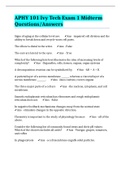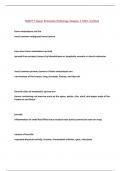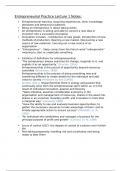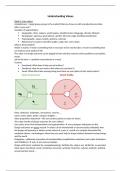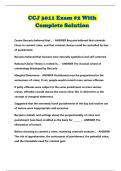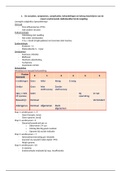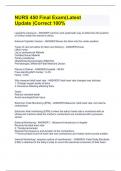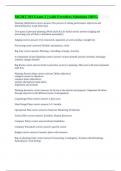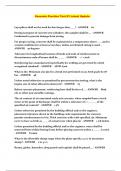Module 7:
Shelf-life modeling is used to predict when food goes bad. You basically want to
determine how long it takes before the food reaches a certain critical limit. This
critical limit is food type dependent.
- Life of a product: time period during which the product performs satisfactorily. In
the case of foods, the life is called shelf-life.
- Shelf-life: the time during which a food remains acceptable for consumption.
There is thus an interplay between the food and the consumer!
Not all food products will fail/go bad at the same time; there is a distribution of
lifetimes follows the probability model (bathtub model).
The shelf-life is not the same as the expiration date.
o The shelf-life has to do with food quality, the expiration date has to do with
food safety.
- Use by date: products should not be used after this date. Used for vulnerable
products, including fish and meat.
- Best before date: products are still safe to consume after this date, but the quality
may be less. Used for e.g., frozen, dried and sterilized products.
Variables to consider with respect to shelf-life:
o Nature of the food.
o Composition.
o Ingredients.
o Processing applied.
o Packaging used.
o Storage conditions.
o Distribution and handling by retailers and consumers.
There is a certain hierarchy of important factors:
1. Food safety.
2. Nutritional requirements.
3. Sensorial aspects.
Food safety:
Microbiological properties determine the shelf-life for the following foods:
o Pasteurized product.
o Soft cheeses, desserts.
o Meat/fish.
o Fresh products.
Nutritional requirements:
The degradation of nutritional compounds happens in all foods. However, it is a
determinant of the shelf-life for the following foods:
o Foods with specific health or nutritional claims.
o Infant formula.
o Clinical foods.
, o Foods for elderly.
In the vast majority of products, the shelf-life is determined by the sensory shelf-life
sensory aspects are often crucial!
The deterioration of food during storage is often the result of different processes
taking place simultaneously, which underly sensory changes:
o Microbiological processes.
o (Bio)chemical processes.
o Physical processes.
Loss of texture, formation of undesired flavor compounds, water migration, oxidation,
etc.
Consumers are the ultimate judges of food quality (critical attributes) and therefore
of the shelf-life.
o The problem with scientific literature on the shelf-life of foods is that
frequently the researcher defines the end point, rather than the consumer.
The shelf-life of foods is thus determined by microbiological, (bio)chemical and
physical changes, but it is influenced by environmental conditions, including
packaging, temperature, RH and light.
Many activities in food technology aim at prolonging the shelf-life of foods.
o Preservation technologies.
o Controlled atmosphere packaging (CAP), modified atmosphere packaging
(MAP).
o Cooling/freezing.
To predict the microbial shelf-life, you use microbiological models.
o Safety and spoilage.
To predict the (bio)chemical shelf-life, you use (bio)chemical models (for changes in
the concentration of certain compounds).
o Nutrition: oxidation (fats, vitamins).
o Color: carotenoids, anthocyanins, Maillard reaction, enzymatic browning.
o Taste: oxidation, Maillard reaction, lipolysis, proteolysis.
To predict the physical shelf-life, you use physical models mass transfer models.
o Creaming.
o Moisture migration.
o Textural changes.
- Rejection level: the level above which the product is assumed not to be acceptable
anymore.
There is a certain relation between the water content and water activity (aw). This
relation depends on the type of product.
o Different empirical models describe this relation. You can use these models to
either describe water transfer through the packaging material, or through the
different parts of the product.
Shelf-life modeling is used to predict when food goes bad. You basically want to
determine how long it takes before the food reaches a certain critical limit. This
critical limit is food type dependent.
- Life of a product: time period during which the product performs satisfactorily. In
the case of foods, the life is called shelf-life.
- Shelf-life: the time during which a food remains acceptable for consumption.
There is thus an interplay between the food and the consumer!
Not all food products will fail/go bad at the same time; there is a distribution of
lifetimes follows the probability model (bathtub model).
The shelf-life is not the same as the expiration date.
o The shelf-life has to do with food quality, the expiration date has to do with
food safety.
- Use by date: products should not be used after this date. Used for vulnerable
products, including fish and meat.
- Best before date: products are still safe to consume after this date, but the quality
may be less. Used for e.g., frozen, dried and sterilized products.
Variables to consider with respect to shelf-life:
o Nature of the food.
o Composition.
o Ingredients.
o Processing applied.
o Packaging used.
o Storage conditions.
o Distribution and handling by retailers and consumers.
There is a certain hierarchy of important factors:
1. Food safety.
2. Nutritional requirements.
3. Sensorial aspects.
Food safety:
Microbiological properties determine the shelf-life for the following foods:
o Pasteurized product.
o Soft cheeses, desserts.
o Meat/fish.
o Fresh products.
Nutritional requirements:
The degradation of nutritional compounds happens in all foods. However, it is a
determinant of the shelf-life for the following foods:
o Foods with specific health or nutritional claims.
o Infant formula.
o Clinical foods.
, o Foods for elderly.
In the vast majority of products, the shelf-life is determined by the sensory shelf-life
sensory aspects are often crucial!
The deterioration of food during storage is often the result of different processes
taking place simultaneously, which underly sensory changes:
o Microbiological processes.
o (Bio)chemical processes.
o Physical processes.
Loss of texture, formation of undesired flavor compounds, water migration, oxidation,
etc.
Consumers are the ultimate judges of food quality (critical attributes) and therefore
of the shelf-life.
o The problem with scientific literature on the shelf-life of foods is that
frequently the researcher defines the end point, rather than the consumer.
The shelf-life of foods is thus determined by microbiological, (bio)chemical and
physical changes, but it is influenced by environmental conditions, including
packaging, temperature, RH and light.
Many activities in food technology aim at prolonging the shelf-life of foods.
o Preservation technologies.
o Controlled atmosphere packaging (CAP), modified atmosphere packaging
(MAP).
o Cooling/freezing.
To predict the microbial shelf-life, you use microbiological models.
o Safety and spoilage.
To predict the (bio)chemical shelf-life, you use (bio)chemical models (for changes in
the concentration of certain compounds).
o Nutrition: oxidation (fats, vitamins).
o Color: carotenoids, anthocyanins, Maillard reaction, enzymatic browning.
o Taste: oxidation, Maillard reaction, lipolysis, proteolysis.
To predict the physical shelf-life, you use physical models mass transfer models.
o Creaming.
o Moisture migration.
o Textural changes.
- Rejection level: the level above which the product is assumed not to be acceptable
anymore.
There is a certain relation between the water content and water activity (aw). This
relation depends on the type of product.
o Different empirical models describe this relation. You can use these models to
either describe water transfer through the packaging material, or through the
different parts of the product.

